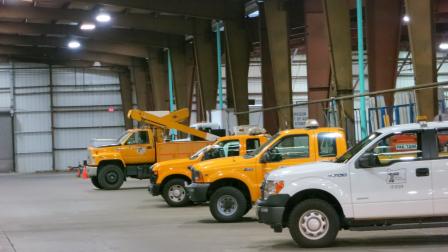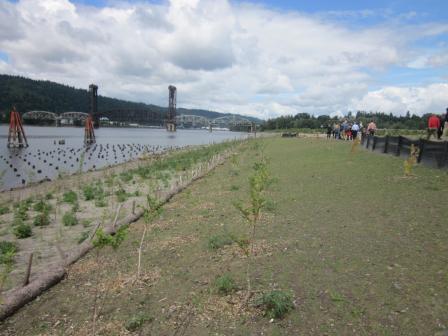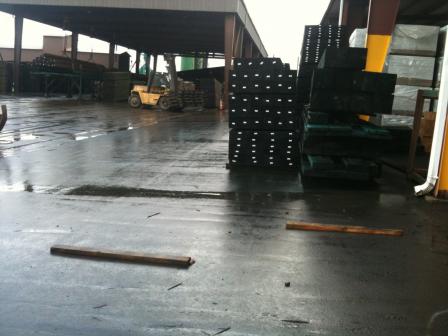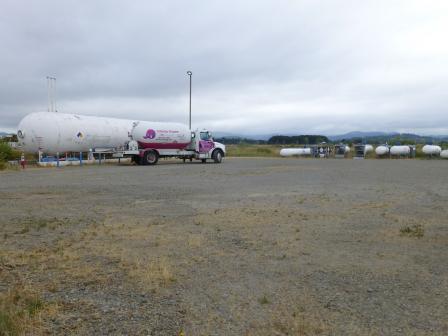Superfund Sites in Reuse in Oregon
If you are having trouble viewing the map in your browser, click the 'View larger map' link below
Allied Plating, Inc.
The 12-acre Allied Plating, Inc. Superfund site is located in Portland, Oregon. On-site plating activities led to heavy metal and cyanide contamination of groundwater, surface water and soil. EPA added the site to the Superfund program's National Priorities List (NPL) in 1990. In 1992, EPA removed contaminated soil and sludge from the site, and treated and disposed of the material in an off-site landfill. EPA then backfilled a low-lying area of the site with rock. In 1993, EPA completed cleanup actions and required the property owner to place a restriction on the property deed to prevent future groundwater use. EPA deleted the site from the NPL in 1994. Basic Fire Protection, a company that makes and installs fire prevention sprinkler systems, continues to occupy a portion of the site. Another portion of the site continues its use as a place for heavy equipment storage.
For more information:
Harbor Oil Inc.
The 4.2-acre Harbor Oil Inc. Superfund site is located in Portland, Oregon in an industrial area adjacent to Force Lake. Harbor Oil Incorporated began cleaning tanker trucks in the 1950’s and recycling oil in 1961. In October 1979, a fire destroyed the facility and ruptured aboveground tanks that stored used oil. Used oil and waste paint flowed across the site into wetlands that border the site and into Force Lake. EPA added the site to the Superfund program's National Priorities List (NPL) in 2003. Site investigation results showed that the site contamination does not pose an unacceptable risk to human health or the environment. EPA deleted the site from the NPL in 2014. EPA will only require cleanup to take place at the site if new information emerges. American Petroleum Environmental Services is the current site operator, recycling used oil at the site.
For more information:
Joseph Forest Products
The 18-acre Joseph Forest Products Superfund site is located near the City of Joseph, Oregon. A wood-treating facility operated at the site from 1974 until 1985. Contamination resulted from poor management practices and a fire that destroyed the treatment building and released wood treatment solution into the soil. EPA listed the site on the Superfund program's National Priorities List (NPL) in 1989. Arsenic, lead and other heavy metals required cleanup. EPA removed tons of contaminated soil and debris, placed restrictions on land use and monitored groundwater for three years. EPA deleted the site from NPL in 1999. A resident living on an adjacent property uses the site to pasture cows.
For more information:
McCormick & Baxter Creosoting Co. (Portland Plant)
The McCormick & Baxter Creosoting Co. Superfund site is located on the Willamette River in Portland, Oregon. The site area includes a 43-acre facility and 23 acres of the Willamette River. From 1944 to 1991, various wood treatment operations occurred on site. During this time, workers disposed of wastewater directly into the river and in tanks on various parts of the site. Two major creosote spills occurred in 1950 and 1956. Wood treating activities ended in 1991. The Oregon Department of Environmental Quality (ODEQ) concluded that wood treating operations resulted in contaminated site soils, groundwater and river sediments. EPA added the site to the Superfund program’s National Priorities List (NPL) in 1994. Under an agreement with EPA, ODEQ cleaned up the site. ODEQ removed and disposed of wood-treating wastes and contaminated soils, and demolished and removed on-site buildings. ODEQ also collects and treats contaminated groundwater. In 2004, ODEQ completed construction of a 23-acre sediment cap that continues to protect the Willamette River, which is an ecological and recreational feature in the heart of Portland. EPA continues to monitor the sediment cap. Even before cleanup reached completion, interested parties began looking at potential redevelopment opportunities for the riverfront site. In 2001, the City of Portland Bureau of Planning, under a grant from EPA, conducted a Site Reuse Assessment. The assessment, endorsed by the Portland City Council, clarified that likely future reuse includes passive and active recreational use. During cleanup, ODEQ revegetated the former facility area with native plant species that prevent erosion. Cottonwoods, willows and spiraea now cover the riverbanks as well.
For more information:
North Ridge Estates
The North Ridge Estates Superfund site is located in Klamath Falls, Oregon. The site spans about 170 acres of residential properties. A large portion of the site formerly contained barracks for the U.S. Navy. After the barracks closed in 1946, the site changed ownership for different uses. Eventually, parties demolished buildings on site and began construction of a residential subdivision. Due to improper demolition practices, asbestos from demolished buildings contaminated area soils and sediments. EPA added the site to the Superfund program’s National Priorities List (NPL) in 2011. Since 2003, EPA has removed 60 tons of asbestos-containing materials from the ground surface every year. In 2015, EPA will finalize a cleanup design to remove between 2 and 4 feet of contaminated soils from privately-owned properties and backfill areas with clean soil. Workers will cover contaminated materials with a protective cap or asphalt. Cleanup efforts also include installing new trees, septic systems and sidewalks. EPA continues to develop cleanup plans and will begin construction in 2016.
For more information:
Northwest Pipe & Casing/Hall Process Company
 Northwest Pipe & Casing/Hall Process CompanyThe 53-acre Northwest Pipe & Casing/Hall Process Company Superfund site is located in an industrial park in Clackamas, Oregon. Operators conducted pipe manufacturing and coating operations at the site from 1956 to 1985. Improper waste disposal activities resulted in the contamination of surface water, soil and groundwater. EPA listed the site on the Superfund program's National Priorities List (NPL) in 1992. Site cleanup included demolition and removal of all site infrastructure, removal and off-site disposal of contaminated soils, and placement of a 2-foot clean soil cap over contaminated areas of soil.. EPA also treated contaminated groundwater on site. Groundwater monitoring continues. The site consists of two parcels: Parcel A, which consists of an 11-acre western lot and a 9-acre eastern lot, and the 30-acre Parcel B. The Oregon Department of Transportation (ODOT) owns the 11-acre western lot of Parcel A. ODOT operates a warehouse, office space, equipment yard, and greenhouse and plant nursery on the lot. An automated card-lock fueling station is also located in the western end of the equipment yard. The Northwest Development Corporation owns the 9-acre eastern lot of Parcel A. The Clackamas Commerce Park occupies the lot, which consists of three warehouse/office spaces and associated parking lots. Clackamas County Development Agency purchased Parcel B in 2005. In 2009, the development agency leased the parcel to Oregon Iron Works, which completed a laydown yard in the northeast corner of Parcel B in fall 2009. In summer 2010, Oregon Iron Works completed construction of a streetcar test track and maintenance facility on the southern half of Parcel B. ODOT is constructing a highway across the entire length of both parcels. The highway, known as the Sunrise Corridor, will run from the northwest corner of Parcel A to the southeast corner of Parcel B. EPA coordinated with ODOT on the construction of the Sunrise Corridor. ODOT began construction of the Sunrise Corridor, which will reach completion in late 2016.
Northwest Pipe & Casing/Hall Process CompanyThe 53-acre Northwest Pipe & Casing/Hall Process Company Superfund site is located in an industrial park in Clackamas, Oregon. Operators conducted pipe manufacturing and coating operations at the site from 1956 to 1985. Improper waste disposal activities resulted in the contamination of surface water, soil and groundwater. EPA listed the site on the Superfund program's National Priorities List (NPL) in 1992. Site cleanup included demolition and removal of all site infrastructure, removal and off-site disposal of contaminated soils, and placement of a 2-foot clean soil cap over contaminated areas of soil.. EPA also treated contaminated groundwater on site. Groundwater monitoring continues. The site consists of two parcels: Parcel A, which consists of an 11-acre western lot and a 9-acre eastern lot, and the 30-acre Parcel B. The Oregon Department of Transportation (ODOT) owns the 11-acre western lot of Parcel A. ODOT operates a warehouse, office space, equipment yard, and greenhouse and plant nursery on the lot. An automated card-lock fueling station is also located in the western end of the equipment yard. The Northwest Development Corporation owns the 9-acre eastern lot of Parcel A. The Clackamas Commerce Park occupies the lot, which consists of three warehouse/office spaces and associated parking lots. Clackamas County Development Agency purchased Parcel B in 2005. In 2009, the development agency leased the parcel to Oregon Iron Works, which completed a laydown yard in the northeast corner of Parcel B in fall 2009. In summer 2010, Oregon Iron Works completed construction of a streetcar test track and maintenance facility on the southern half of Parcel B. ODOT is constructing a highway across the entire length of both parcels. The highway, known as the Sunrise Corridor, will run from the northwest corner of Parcel A to the southeast corner of Parcel B. EPA coordinated with ODOT on the construction of the Sunrise Corridor. ODOT began construction of the Sunrise Corridor, which will reach completion in late 2016.
For more information:
- Reuse and the Benefit to Community: Northwest Pipe & Casing/Hall Process Company Case Study (2015) (PDF)(10 pp, 1.1 MB, About PDF)
- Superfund Site Profile Page
Portland Harbor
 Portland HarborThe Portland Harbor Superfund site is located in Portland, Oregon. The site study area includes a 10-mile stretch of the lower Willamette River known generally as Portland Harbor, and associated upland source properties. For over 150 years, Portland Harbor has served as an international port for commerce. The surrounding properties have supported manufacturing, shipbuilding, petroleum, metal salvaging and power-generation activities. These industrial uses resulted in contamination of river water and sediment, and upland soil and groundwater at riverfront properties. There are public beaches and parks within the Site and recreational uses of the river in the Site as well. In 2000, EPA placed the site on the Superfund program’s National Priorities List (NPL). Through a Bona Fide Prospective Purchaser Doing Work Agreement with EPA, the University of Portland purchased the 35-acre Triangle Park area of the site in 2008. The University of Portland with EPA oversight cleaned up the area. This preliminary work ensures that activities remain consistent with long-term cleanup goals for the site as a whole. The university anticipates that the transformed industrial property will provide housing and athletic fields. A trail will also provide public access to the Willamette River waterfront for members of the university community. Other areas of the site are currently ready for reuse. A habitat development and land management company is developing a restoration project at Alder Creek on Sauvie Island. The project goal is to create natural resource credits which will be made available for purchase to potentially responsible parties as a mechanism for environmental damage compensation. A 32-acre active sawmill complex on the site will be removed and the site will be restored using a mosaic of riparian, channel, tidal marsh, and mud flat habitats.
Portland HarborThe Portland Harbor Superfund site is located in Portland, Oregon. The site study area includes a 10-mile stretch of the lower Willamette River known generally as Portland Harbor, and associated upland source properties. For over 150 years, Portland Harbor has served as an international port for commerce. The surrounding properties have supported manufacturing, shipbuilding, petroleum, metal salvaging and power-generation activities. These industrial uses resulted in contamination of river water and sediment, and upland soil and groundwater at riverfront properties. There are public beaches and parks within the Site and recreational uses of the river in the Site as well. In 2000, EPA placed the site on the Superfund program’s National Priorities List (NPL). Through a Bona Fide Prospective Purchaser Doing Work Agreement with EPA, the University of Portland purchased the 35-acre Triangle Park area of the site in 2008. The University of Portland with EPA oversight cleaned up the area. This preliminary work ensures that activities remain consistent with long-term cleanup goals for the site as a whole. The university anticipates that the transformed industrial property will provide housing and athletic fields. A trail will also provide public access to the Willamette River waterfront for members of the university community. Other areas of the site are currently ready for reuse. A habitat development and land management company is developing a restoration project at Alder Creek on Sauvie Island. The project goal is to create natural resource credits which will be made available for purchase to potentially responsible parties as a mechanism for environmental damage compensation. A 32-acre active sawmill complex on the site will be removed and the site will be restored using a mosaic of riparian, channel, tidal marsh, and mud flat habitats.
For more information:
Reynolds Metals Company
 Reynolds Metals CompanyThe Reynolds Metals Company Superfund site is located 20 miles from Portland, Oregon, outside the City of Troutland. The site includes an 80-acre former aluminum smelter plant and about 700 surrounding acres. Investigations found contaminated groundwater, surface water, sediments and soils on site. This resulted in EPA listing the site on the Superfund program's National Priorities List (NPL) in 1994. From 1995 until 2008, Reynolds Metal Company completed most cleanup actions at the site. In 2000, Alcoa purchased and proceeded to close the plant. By 2008, Alcoa had demolished all plant buildings. That same year, the Port of Portland bought the 700-acre site from Alcoa and developed it as the Troutdale Reynolds Industrial Park. The Port of Portland sold the first 78-acre parcel to FedEx Ground, which built a 460,000-square-foot regional distribution center. The $200 million center opened in October 2010 and will employ about 1,100 people when it is operational. The Port of Portland plans to develop a further 280 acres for industrial uses. The Port will set aside the rest of the land for infrastructure, open space, wetlands and a recreational trail. In 2010, the Port received a national Phoenix Award for achievement of excellence in Superfund site reuse.
Reynolds Metals CompanyThe Reynolds Metals Company Superfund site is located 20 miles from Portland, Oregon, outside the City of Troutland. The site includes an 80-acre former aluminum smelter plant and about 700 surrounding acres. Investigations found contaminated groundwater, surface water, sediments and soils on site. This resulted in EPA listing the site on the Superfund program's National Priorities List (NPL) in 1994. From 1995 until 2008, Reynolds Metal Company completed most cleanup actions at the site. In 2000, Alcoa purchased and proceeded to close the plant. By 2008, Alcoa had demolished all plant buildings. That same year, the Port of Portland bought the 700-acre site from Alcoa and developed it as the Troutdale Reynolds Industrial Park. The Port of Portland sold the first 78-acre parcel to FedEx Ground, which built a 460,000-square-foot regional distribution center. The $200 million center opened in October 2010 and will employ about 1,100 people when it is operational. The Port of Portland plans to develop a further 280 acres for industrial uses. The Port will set aside the rest of the land for infrastructure, open space, wetlands and a recreational trail. In 2010, the Port received a national Phoenix Award for achievement of excellence in Superfund site reuse.
For more information:
- Reuse and the Benefit to Community: Reynolds Metals Company Case Study (2015) (PDF)(11 pp, 1.8 MB, About PDF)
- Superfund Site Profile Page
Taylor Lumber and Treating
 Taylor Lumber and TreatingThe Taylor Lumber and Treating Superfund site is located in Sheridan, Oregon. From 1966 to 2001, Taylor Lumber and Treating pressure treated logs for use as utility poles and pilings. Drips, spills and leaks of wood-treating chemicals resulted in groundwater and soil contamination at the site and in nearby roadside ditches. The facility ceased operations and filed for bankruptcy in 2001. EPA listed the site on the National Priorities List (NPL) that same year. In 2007 and 2008, EPA completed site cleanup actions, which included removal and off-site disposal of contaminated soils from nearly 5 acres of the. EPA restricted groundwater use and non-industrial land use at the site. The State of Oregon is responsible for long-term groundwater monitoring and oversight of maintenance of a low-permeability asphalt cap in the treatment area. In 2002, Pacific Wood Preserving of Oregon (PWPO) entered into a Prospective Purchaser Agreement with EPA and purchased the 40-acre wood-treating facility. In 2011, EPA revised and updated the agreement. In 2013, Stella-Jones Corporation and McFarland Cascade Holdings purchased the Sheridan PWPO facility. Currently, the facility manufactures transmission poles, telephone and utility poles, distribution poles, and laminated beams at the site.
Taylor Lumber and TreatingThe Taylor Lumber and Treating Superfund site is located in Sheridan, Oregon. From 1966 to 2001, Taylor Lumber and Treating pressure treated logs for use as utility poles and pilings. Drips, spills and leaks of wood-treating chemicals resulted in groundwater and soil contamination at the site and in nearby roadside ditches. The facility ceased operations and filed for bankruptcy in 2001. EPA listed the site on the National Priorities List (NPL) that same year. In 2007 and 2008, EPA completed site cleanup actions, which included removal and off-site disposal of contaminated soils from nearly 5 acres of the. EPA restricted groundwater use and non-industrial land use at the site. The State of Oregon is responsible for long-term groundwater monitoring and oversight of maintenance of a low-permeability asphalt cap in the treatment area. In 2002, Pacific Wood Preserving of Oregon (PWPO) entered into a Prospective Purchaser Agreement with EPA and purchased the 40-acre wood-treating facility. In 2011, EPA revised and updated the agreement. In 2013, Stella-Jones Corporation and McFarland Cascade Holdings purchased the Sheridan PWPO facility. Currently, the facility manufactures transmission poles, telephone and utility poles, distribution poles, and laminated beams at the site.
For more information:
Teledyne Wah Chang
The Oremet-Wah Chang (OWC) plant (formerly Teledyne Wah Chang) plant is located in Millersburg, Oregon. The facility is one of the country's largest producers of rare earth metals and alloys. The Teledyne Wah Chang Superfund site includes the 110-acre plant, a 115-acre area made up of four ponds containing sludges from the plant's wastewater treatment facility, and a 60-acre field where operators used sludges containing radium as a soil amendment. Production at the site began in 1957. Past disposal practices resulted in the contamination of soil, sediments and groundwater. EPA listed the site on the Superfund program's National Priorities List (NPL) in 1983. OWC completed cleanup actions to address contaminated sediments and soil in 1999. In 2000, OWC began operating a groundwater treatment system that continues to extract and treat groundwater today. With EPA’s approval, OWC enhanced the system in 2009 by adding microbial remediation technologies to address additional areas of contaminated groundwater. The OWC plant continues to operate, employing several hundred workers.
For more information:
Union Pacific Railroad Co. Tie-Treating Plant
The 83-acre Union Pacific Railroad Co. Tie-Treating Plant Superfund site is located in The Dalles, Oregon south of the Columbia River. Union Pacific owned the wood treatment facility from 1926 until 1987. The facility treated railroad ties for Union Pacific and other commercial users. In 1987, the Kerr-McGee Chemical Corporation purchased the facility equipment and structures. Union Pacific retained ownership of the land and responsibility for all pre-1987 contamination of soil and groundwater. The main sources of contamination were wastewater ponds and spills of treatment solutions. EPA added the site to the Superfund program's National Priorities List (NPL) in 1990. Cleanup activities included removing contaminated debris and soil, installing a water treatment plant and three wells to remove contamination and placing a topsoil cover on surface soils to prevent any exposure to remaining low-level soil contamination. Today, Amerities West, LLC, operates a wood-treating facility on site.
For more information:
United Chrome Products, Inc.
 United Chrome Products, Inc.The United Chrome Products, Inc. Superfund site is located just south of Corvallis, Oregon. Owned by the City of Corvallis, the 1.5-acre site is a former industrial hard-chrome plating facility. Non-food grass seed farming, aviation and light industrial uses surround the site. Site activities contaminated soil and groundwater with chrome and other hazardous waste. EPA listed the site on the Superfund program's National Priorities List (NPL) in 1984. In 1985, EPA removed chrome-contaminated liquids and disposed of hazardous waste off site. Some contamination remains in groundwater in an isolated area of the site. The City continues to pump groundwater and perform long-term groundwater monitoring. The City currently leases most of the property to Helicopter Transport Services for use as an equipment staging area. CoEnergy leases a portion of the site for truck parking and propane distribution. The City has plans for an aboveground oil depot and for a ground-mounted solar array on a portion of the airport property.
United Chrome Products, Inc.The United Chrome Products, Inc. Superfund site is located just south of Corvallis, Oregon. Owned by the City of Corvallis, the 1.5-acre site is a former industrial hard-chrome plating facility. Non-food grass seed farming, aviation and light industrial uses surround the site. Site activities contaminated soil and groundwater with chrome and other hazardous waste. EPA listed the site on the Superfund program's National Priorities List (NPL) in 1984. In 1985, EPA removed chrome-contaminated liquids and disposed of hazardous waste off site. Some contamination remains in groundwater in an isolated area of the site. The City continues to pump groundwater and perform long-term groundwater monitoring. The City currently leases most of the property to Helicopter Transport Services for use as an equipment staging area. CoEnergy leases a portion of the site for truck parking and propane distribution. The City has plans for an aboveground oil depot and for a ground-mounted solar array on a portion of the airport property.
For more information:
